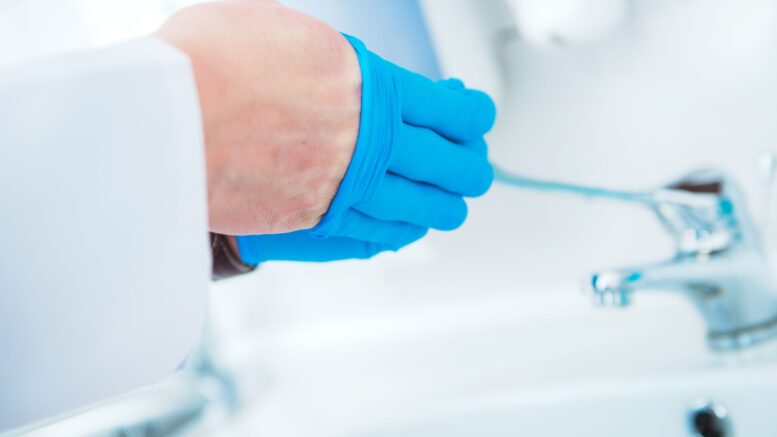Lack of glove changes at COVID-19 testing centers in Belgium led to major cross-contamination of samples and a high rate of false positive results, research being presented at this year’s European Congress of Clinical Microbiology & Infectious Diseases (ECCMID) in Lisbon, Portugal, April 23-26, has found.
The introduction of large-scale PCR testing for COVID-19 presented a number of logistical challenges, including a scarcity of personnel adequately trained to do nasopharyngeal swabbing.
Research from a government-funded lab in Belgium has identified inadequate PPE management in testing centers as a source of major cross-contamination.
Scientists at the COVID-19 Federal Platform, Department of Laboratory Medicine UZ Leuven, Leuven, Belgium were alerted to the problem in September 2021 when they noticed that 70% of samples taken that day at a testing center in Flemish Brabant, Flanders, had tested positive for COVID-19. The average positivity rate at the time was around 5-10%.
90% of the positive samples had a very low viral load, which hinted that they had been contaminated with the SARS-CoV-2 virus, rather than being true positives.
The patients’ results were immediately withheld and a root-cause analysis (an investigation into the cause of the spike in positive samples) carried out.
Lead researcher Bram Slechten says, “After excluding lab contamination we arranged the results from that day in chronological order by time of sample collection. We saw that no one had tested negative after a sample was collected from a patient with a very high viral load and immediately contacted the test center. This led to lack of glove-changing, in combination with high-paced sample collection by a new swabber and the breaking of a swab in the tube, being identified as the likely source of the contamination. Protocols at this test center were sharpened overnight and all the patients whose results were withheld were recalled for a new sample the next day. 100% of them were negative.”
To assess the scale of the problem, Slechten and colleagues then retrospectively checked four months of results (June-Sept 2021) of PCR tests from 11 testing centers for false positives.
A suspected series of contaminated samples was defined as a minimum of three weak positive samples (low viral load, <104 copies RNA/mL) after one positive sample with a high viral load (>106 copies RNA/mL).
They also visited the sites to assess the personnel.
The analysis identified potential cross-contamination events in 73% (8/11) of the test centers. The percentage of samples suspected of being wrongly reported as positive widely varied per day and per center. The four-month average ranged from 0% to 3.4% per testing centre.
The highest number of false positives at one testing center on a single day was 77 (out of 382 tests) − 20% of people tested that day. (All of these patients were given the opportunity to retest.)
Site visits identified lack of glove changes between patients are being the source of cross-contamination.
“If the staff didn’t change gloves between each patient, it was almost certain that contamination would occur,” says Slechten. “We identified four reasons why changing of gloves didn’t happen: it was simply not in the protocol; correct protocol was in place but it was not followed due to lack of training of new members of staff; not having the right size of glove available; work pressure, some swabbers had to sample one patient every two minutes.”
More rigorous PPE policies were put in place at all 11 testing centers from the end of October 2021, in response to the study’s results.
This included managers being tasked with telling every staff member who swabbed patients about the importance of glove changing and test centers being contacted if there was a spike in their false positive rate.
Follow-up of one test center revealed the impact. Before the intervention, it had a daily positivity rate of 11% and an average false positivity rate of 3.4%. But occasionally, the false positive rate rose to 20%. After the intervention, the false positive rate fell to almost zero.
The team at UZ-Leuven is continuing to monitor rates of false positives, to detect any isolated cross-contamination events.
In addition, Sciensano (the Belgian scientific institute for public health) alerted all labs in Belgium to the issue in October 2021.
The researchers say that most of cases of cross-contamination were detected in time to withhold the results and recall the patients, meaning the erroneous results weren’t given out. Some cases, however, went undetected, meaning that on some days, a lot of patients received a wrong result.
Slechten says, “Nasopharyngeal sampling involves close contact between the hand of the health professional, the patient and sample tube. Therefore, it is essential to change gloves between each patient. In the context of high-throughput sampling, insufficiently trained staff had to sample high numbers of patients in a limited time. This situation led to a high level of cross-contamination which had gone largely unrecognized, resulting in false positives and people self-isolating and taking time off work unnecessarily. Furthermore, each false positive generates high-risk contacts who may also need to be tested, increasing the burden for labs, testing centers and contact tracing.”
He believes the false positives artificially inflated the COVID-19 case numbers for Belgium. He says: “It is hard to put a number on, however, because we saw a lot of differences between the test centers we studied. In addition, we only looked at test centers in one part of Belgium, making it hard to get the whole picture. It is very probable that this also occurred in other countries. While I don’t have detailed knowledge of the protocols in testing centers in other countries, the focus is generally on potential events within the lab environment. However, our research provides a perfect example of the importance of looking beyond the lab and keeping an eye on the entire testing chain.”
Source: European Congress of Clinical Microbiology & Infectious Diseases (ECCMID)
